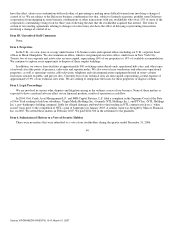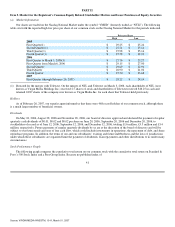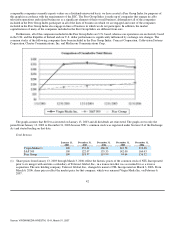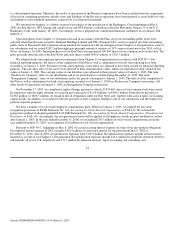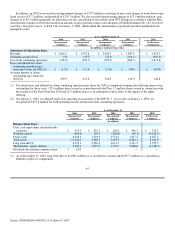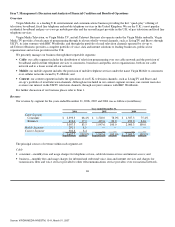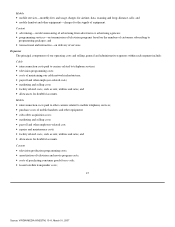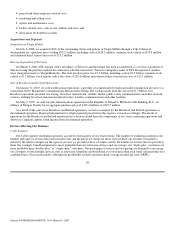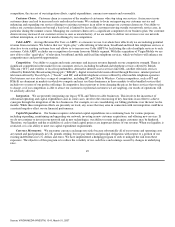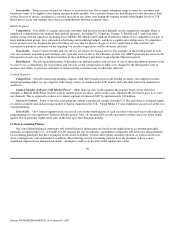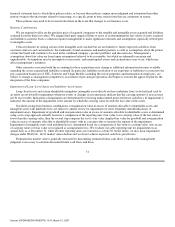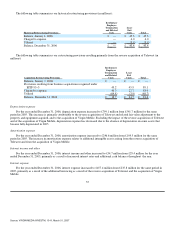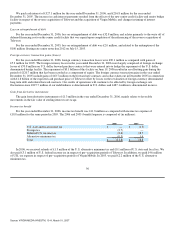Virgin Media 2006 Annual Report Download - page 54
Download and view the complete annual report
Please find page 54 of the 2006 Virgin Media annual report below. You can navigate through the pages in the report by either clicking on the pages listed below, or by using the keyword search tool below to find specific information within the annual report.
Seasonality. Some revenue streams are subject to seasonal factors. For example, telephone usage revenue by customers and
businesses tends to be slightly lower during summer holiday months. Our customer churn rates include persons who disconnect their
service because of moves, resulting in a seasonal increase in our churn rates during the summer months when higher levels of U.K.
house moves occur and students leave their accommodations between academic years.
Mobile Segment
Competition. Our ability to acquire and retain customers and increase revenue depends on our competitive strength. There is
significant competition in our markets from mobile operators, including O2, Vodafone, Orange, T−Mobile and 3, and from other
mobile virtual network operators, including Tesco Mobile, BT Mobile and Carphone Warehouse. Many of our competitors are part of
large multinational groups, have substantial advertising and marketing budgets, and have a significant retail presence. If competitive
forces prevent us from charging the prices for these services that we plan to charge, or if our competition is able to attract our
customers or potential customers we are targeting, our results of operations will be adversely affected.
Seasonality. Some revenue streams and cost drivers are subject to seasonal factors. For example, in the fourth quarter of each
year our customer acquisition and retention costs typically increase due to the Christmas period. Our ARPU generally decreases in the
first quarter of each year due to the fewer number of days in February and lower usage after the Christmas period.
Distribution. We rely upon third parties to distribute our mobile products and services. If any of these distribution partners were
to cease to act as distributors for our products and services, or the commissions or other costs charged by the third parties were to
increase, our ability to gain new customers or retain existing customers may be adversely affected.
Content Segment
Competition. Our television programming competes with other broadcasters for advertising revenues, subscription revenues,
and programming rights. sit−up competes with a large variety of retailers in the U.K. market and with other television channels for
audiences.
Limited Number of Buyers with Market Power. Other than our own Cable segment, the primary buyer of our television
channels is BSkyB. BSkyB has recently used its market power to reduce, and in some cases, eliminate the fees that it pays us to carry
our channels. This is expected to reduce our content segment revenues in 2007 by approximately £30 million.
Access to Content. Some of the television program content is purchased, mainly from the U.S. Because there is a limited supply
of content available and an increasing number of digital channels in the U.K., Virgin Media TV may experience an increase in the cost
of programming.
Seasonality. Our Content segment incurs increased costs in the fourth quarter of each year due to the need to provide enhanced
programming over the important Christmas holiday period. Also, sit−up generally records increased revenues and costs in the fourth
quarter due to generally higher retail sales in the lead up to the Christmas holiday.
Critical Accounting Policies
Our consolidated financial statements and related financial information are based on the application of accounting principles
generally accepted in the U.S., or GAAP. GAAP requires the use of estimates, assumptions, judgments and subjective interpretations
of accounting principles that have an impact on the assets, liabilities, revenue and expense amounts reported, as well as disclosures
about contingencies, risk and financial condition. The following critical accounting policies have the potential to have a more
significant impact on our financial statements. An impact could occur because of the significance of the
50
Source: VIRGIN MEDIA INVESTM, 10−K, March 01, 2007


